Body Plans and Nutritional Mode | Classification of Fungi | Zygomycetes | Ascomycetes
Basidiomycetes | Lichens and Mycorrhizae | Links
Fungi are almost entirely multicellular (with yeast, Saccharomyces cerviseae, being a prominent unicellular fungus), heterotrophic (deriving their energy from another organism, whether alive or dead), and usually having some cells with two nuclei (multinucleate, as opposed to the more common one, or uninucleate) per cell. Ecologically this kingdom is important (along with certain bacteria) as decomposers and recyclers of nutrients. Economically, the Fungi provide us with food (mushrooms; Bleu cheese/Roquefort cheese; baking and brewing), antibiotics (the first of the wonder drugs, penicillin, was isolated from the fungus Penicillium), and crop parasites (doing several million dollars per year of damage).
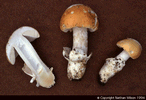

The above images are from http://www.cinenet.net/users/velosa/thumbnails.html.
Evolution of multicellular eukaryotes increased the size and complexity of organisms, allowing them to exploit the terrestrial habitat. Fungi first evolved in water but made the transition to land through the development of specialized structures that prevented their drying out. First classified as plants, fungi are now considered different enough from plants to be placed in a separate kingdom.
Fungi contain unicellular, multinucleate, and multicellular forms.They are classified on the basis of their reproductive spores and the nature of their multinucleate or multicellular filaments known as hyphae. Fungal cells have cell walls containing the carbohydrate chitin.
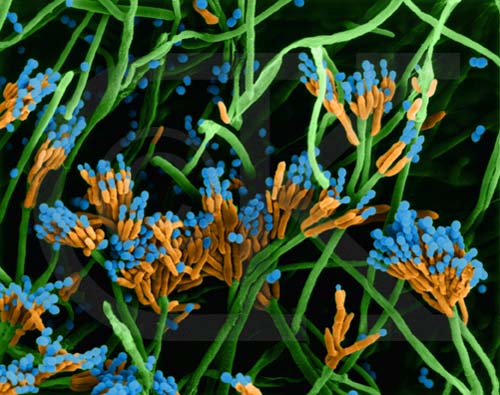
SEM image (color added) of fungal mycelium with hyphae (green), sporangia (orange) and spores (blue), Penicillium sp. (SEM x1,560). This image is copyright Dennis Kunkel http://www.pbrc.hawaii.edu/~kunkel/gallery, used with permission.
Fungi are absorptive heterotrophs: they breakdown food by secreting digestive enzymes onto a substrates and then absorbing the resulting small food molecules. Fungal hyphae have a small volume but large surface area, enhancing the fungal absorptive capacity.
Fungal hyphae are collectively termed a mycelium. Some fungi are saprophytes, they obtain their food from the decaying bodies of plants and animals. Other fungi are parasites.
Fungi are important both as a source of food and in the preparation of food. Edible fungi include mushrooms, truffles, and morels. Cheeses such as Gorgonzola, Roquefort, Stilton, and bleu have fungal colonies that give theses cheeses their distinctive flavors.
Beer and wine are produced through the action of fungi known as yeasts, such as Saccharomyces cerevisae. Many antibiotics are produced by fungi.
Fungi also are important crop parasites, causing loss of food plants, spoilage of food and some infectious diseases.
Over 60,000 species of fungi are known. Fungi are classified by their method of reproduction (both sexual and asexual). It seems likely that fungi are not a monophyletic group. Historically they have been divided into four taxonomic divisions: Zygomycota, Ascomycota, Basidiomycota, and Deuteromycota.
The Division Zygomycota consists of fewer than 1000 species. The zygomycete hyphae do not have one nucleus per cell, but rather have long multinucleate, haploid hyphae that comprise their mycelia. Asexual reproduction is by spores produced in stalked sporangia.
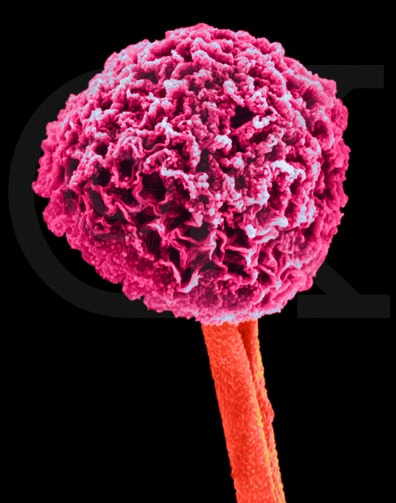
SEM image (color added) of a bread mold fruiting structure, Rhizopus stolonifer , (SEM x2,860). This image is copyright Dennis Kunkel http://www.pbrc.hawaii.edu/~kunkel/gallery, used with permission.
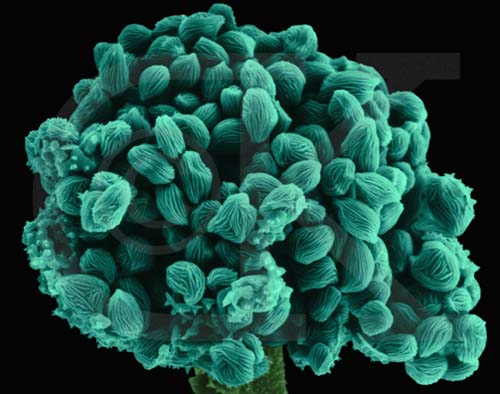
SEM of spores on a fruiting structure of Rhizopus (x2,990). This image is copyright Dennis Kunkel http://www.pbrc.hawaii.edu/~kunkel/gallery, used with permission.
Sexual reproduction involved the fusion of haploid mating hyphae to produce a diploid zygospore.
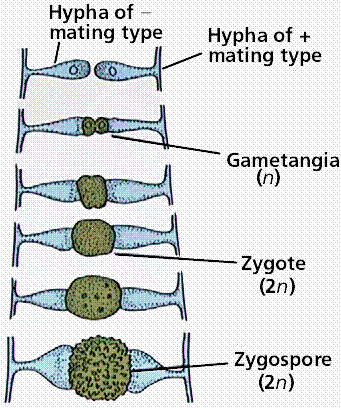
Image from W.H. Freeman and Sinauer Associates, used by permission.
There are less than 1000 species of zygomycetes. Common bread molds are in this group, as are a few species that parasitize plants and animals. Most zygomycetes feed on dead or decaying plant and animal material.
The Division Ascomycota contains more than 30,000 species of unicellular (yeasts) to multicellular fungi. Yeasts reproduce asexually by budding and sexually by forming a sac (or ascus). One yeast, Saccharomyces cerevisiae, is important for genetic research as well as its commercial applications in baking and brewing. Yeasts are part of the Human Genome Project and serve as easily studied models for eukaryotic gene systems. Yeast chromosomes have also been modified to serve as vectors for transporting human DNA fragments for use in gene mapping.
Sac fungi are also important in decomposing and recycling organic matter. Some ascomycetes are parasites responsible for Dutch Elm disease and Chestnut blight. Other sac fungi are used in commercial baking and brewing, wine making, and in the production of antibiotics.
Claviceps purpurea, cause of the crop disease known as wild ergot, is a natural source of the hallucenogen LSD. Some sholars speculate that an outbreak of wild ergot may have been responsible for the hallucinations associated with the Great Awakening in 17th century America.
Mushrooms, toadstools, and puffballs are commonly encountered basidiomycetes. These conspicuous features of the fungi are the reproductive structures known as fruiting bodies (although they do NOT produce fruit). Sexual reproduction involves the formation of basidiospores on club-shaped cells known as basidia.

Image from W.H. Freeman and Sinauer Associates, used by permission.
Club fungi are important as commercial crops. They also cause many diseases that result in loss or reduction of grain yields. Agaricus campestris is the common mushroom found in grocery stores; Lentinus edodes is the less commonly bought shitake mushroom: more than $14 billion per year of these products are sold.
Amanita phalloides is the most poisionous of all mushrooms. Other mushrooms have hallucinogenic properties (such as the drug psilocybin) important in native religious rituals in Central and South America.
Amanita phalloides (Death Cap). Image from http://www.cinenet.net/users/velosa/newpages/Amanita_phalloides.html, used by permission.
Rusts and smuts are significant crop parasites: corn smut almost destroyed the entire US corn crop in the 1970s.
Lichens are a symbiosis between a photosynthetic organism (alga or cyanobacterium) and a fungus (sac or club). Mycorrhizae are fungi (usually a zygomycete or basidiomycete) symbiotic with the roots of plants. Both relationships are mutualistic: both parties benefit. Fungi provide nutrients from the substrate, the phototroph provides food. Plants with mycorrhizae grow better: the plant gets nutrients from the fungus in exchange for carbohydrates.
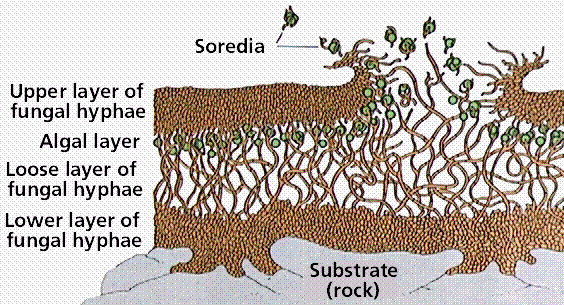
Structure of a lichens. Image from W.H. Freeman and Sinauer Associates, used by permission.
Email: mj.farabee@emcmail.maricopa.edu![]()
Last modified:
2000/01/08:16:54:56
The URL of this page is:
gened.emc.maricopa.edu/bio/BIO181/BIOBK/BioBookDiversity_4.html